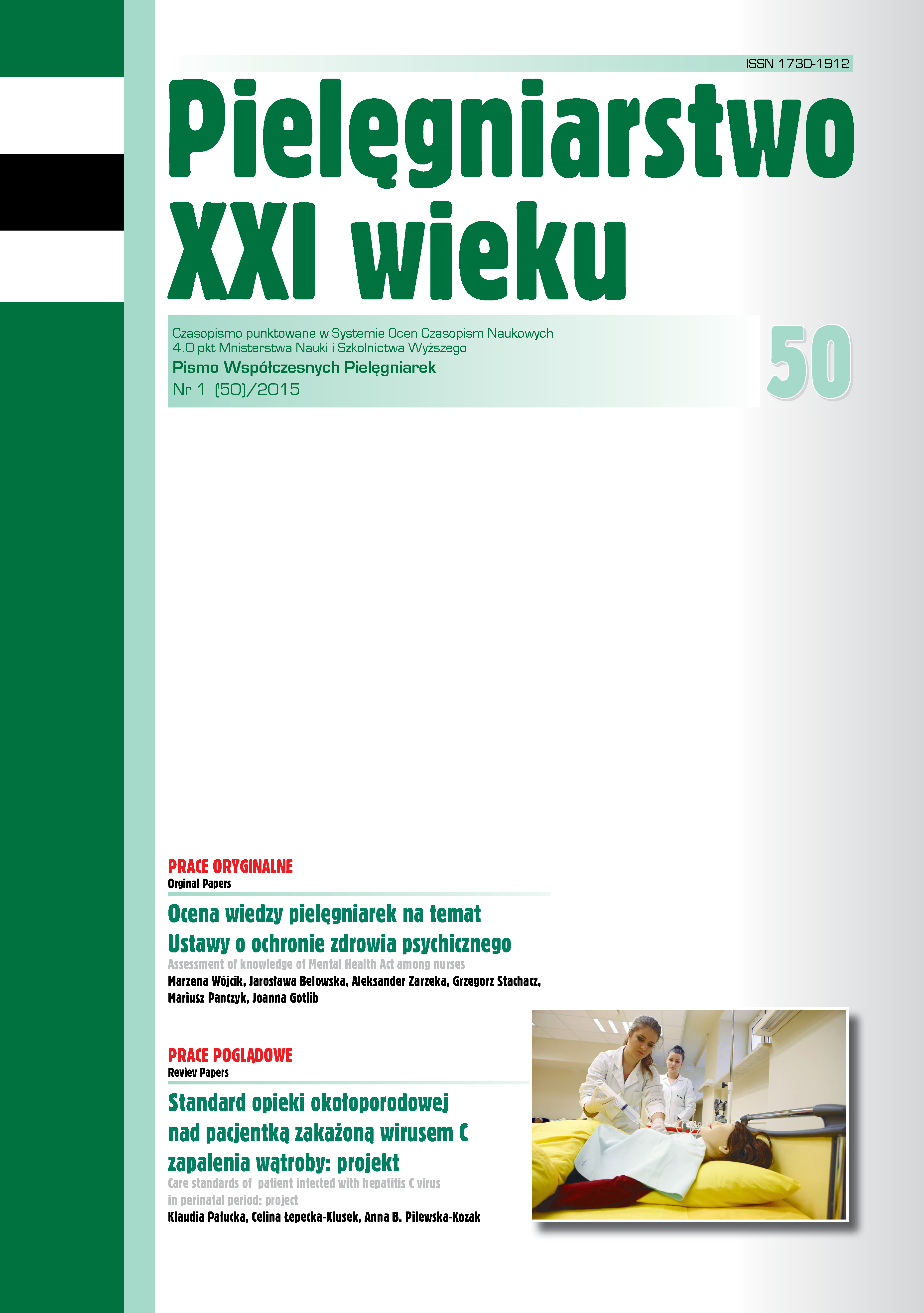Knowledge of diabetic patients on the first symptoms of diabetic foot
DOI:
https://doi.org/10.12923/p21w-2015-1/05Keywords:
diabetic foot syndrome, knowledge, foot careAbstract
KNOWLEDGE OF DIABETIC PATIENTS ON THE FIRST SYMPTOMS OF DIABETIC FOOT
Introduction. Diabetic foot syndrome with multiple clinical pictures, as ulceration, infection, gangrene, necrosis is a major challenge for doctors and nurses and all health service managers. This is a disease which deteriorates the patients’ quality of life, causes frequent hospital admissions as well as increases the risk of disabilities, even if there is no amputation included.
Aim. The aim of the study is to assess diabetic patients’ knowledge about the diabetic foot syndrome and its first symptoms.
Material and methods. The study was conducted on diabetic patients living in Lodz region. The study lasted from October to December 2012. The study involved 100 patients diagnosed with type 1 and 2 diabetes. The study was conducted in the Department of Diabetes in Medical University of Lodz. The study was conducted with a questionnaire designed by authors. It consists of closed questions divided into: alternative questions-predicting two possible answers: yes or no; dysjunctive questions- requiring a choice from more than two possible answers; conjunctive questions- requiring a selection of more than one of the following answers.
Results. The overwhelming majority of respondents were female (60%) while other members of the study group were men (40%). The age of respondents ranged from 30 to 80. Patients between 46 and 60 constituted a largest group in the study.
Conclusion. It was established that the patients affected with Type 1 and 2 diabetes know very little about their disease and its late consequences which is unsatisfactory Diabetic patients fail to care for themselves which is due to their lack of knowledge about the disease, unhealthy habits (like cigarette smoking,) as well as lack of concern for the condition of their feet. Efforts are needed to make education about diabetes more effective.
References
1. Frank B. Hu. Globalization of Diabetes. The role of diet, lifestyle and genes. American Diabetes Association 2011. [Data cytowania 29.12.2014]. Dostępny pod adresem http://care.diabetesjournals.org/content/34/6/1249.full.
2. Moczulski D.: Wielka Interna – Diabetologia. Wydawnictwo Medical Tribune Polska: Warszawa 2010.
3. Valk GD, Kriegsman DM, Assendelft WJ. Patient education for preventing diabetic foot ulceration. Cochrane Database Syst. Rev. 2005; 5: CD 001488.
4. Krakowiecki A. Diagnostyka zespołu stopy cukrzycowej. Przew. Lek. 2005; 3: 54-7.
5. Rosiński G. W trosce o stopę cukrzycową. Warszawa: Marketing & Media; 2004.
6. Karnafel W. Stopa cukrzycowa. Lublin: Wydawnictwo Czelej; 2008: 1-85.
7. Siminerio L, Zgibor J, Solano FXJr. Implementing the chronic care model for improvements in diabetes practice and outcomes in primary care: the University of Pittsburgh Medical Center experience. Clinical Diabetes. 2004; 22: 54-58.
8. Fisher EB, Walker EA, Bostrom A i wsp. Behawioral science research in the prevention of diabetes. Diabetes Care. 2002; 25: 599-606.
9. Tatoń J, Czech A. Edukacja terapeutyczna jako metoda leczenia i ulepszania stylu życia osób z cukrzycą. Diabetol. Pol. 2002; 1:55.
10. Brodawko B, Mosiewicz J, Czepło C. Przewlekłe powikłania cukrzycy i świadomość osób z cukrzycą odnosząca się do problemów ich choroby. Medycyna Metaboliczna. 2005; X (2): 90-94.
11. Szymańska-Pomorska G, Lisowczyk J. Przygotowanie pielęgniarek do działań edukacyjnych wśród chorych na cukrzycę. W: Abramczyk A, Łopatyński J, Prusek W. Cukrzyca – problem społeczny. Wrocław: Zakład Pielęgniarstwa Społecznego AM we Wrocławiu. 2002: 142–151.
12. Hellman RA. Systems approach to reducing errors in insulin therapy in the inpatient setting. Endocrine Practice. 2004; 10 (supl. 2): 100-108.
13. American Diabetes Association. Standards of medical care in diabetes – 2010. Diabetes Care 2007; 30 (supl. 1): S4-S41.
14. Krysoń-Serafin M, Jankowiak B, Krajewska-Kułak E i wsp. Ocena wiedzy pacjentów na temat cukrzycy typu 2 jako niezbędny element terapii. Diabet Dośw Klin. 2005;5;253- 259.
15. Łagoda K, Kamińska K, Kobus G i wsp. Ocena wiedzy pacjentów na temat profilaktyki zespołu stopy cukrzycowej . Przeg kardiodiabetol. 2009;4; 64-70.
16. Naszydłowska E, Kozieł D, Trawczyńska M. Udział pielęgniarki w podnoszeniu jakości życia pacjentów z cukrzycą. Piel. XXI wieku. 2003; 3: 53-56.
17. Wróbel M, Szymborska – Kajanek A, Grzeszczak W i wsp. Leczenie bólu w przebiegu polineuropatii cukrzycowej – współczesne możliwości i perspektywy. Lekarz. 2005;5:52-53.
18. Ismail K, Winkley K, Stahil D i wsp. A cohort study of people with diabetes and their first foot ulcer: the role of depresion on morality. Diabetes Care. 2007;30;1473-9. PMID:17363754.
19. Rubin RR, Gaussoin SA, Payrot M et al. Cardiovascular disease risk factors, depression symptoms and antidepressant medicine use in the Look AHEAD (Action for Health in Diabetes) clinical trial of weight loss in diabetes. Diabetologia. 2010; 53: 1581-9. PMID: 20422396.
20. Lavy D. Praktyczna opieka diabetologiczna. Warszawa: Wydawnictwo Lekarskie PZWL 2013.
21. LeMaster JW, Sugarman JR, Baumgardner G et al. Motivational brochures increase the number of Medicare – eligible persons with diabetes making therapeutic footwear claims. Diabetes Care. 2003; 26: 1679-84.
Downloads
Published
Issue
Section
License
Copyright (c) 2024 Joanna Chrobak-Bień, Anna Gawor, Anna Ignaczak (Autor)

This work is licensed under a Creative Commons Attribution 4.0 International License.




